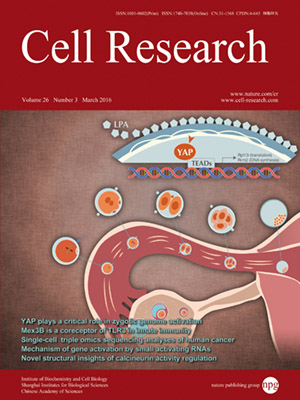
Volume 26, No 3, Mar 2016
ISSN: 1001-0602
EISSN: 1748-7838 2018
impact factor 17.848*
(Clarivate Analytics, 2019)
Volume 26 Issue 3, March 2016: 275-287 | Open Access
ORIGINAL ARTICLES
Oocyte-expressed yes-associated protein is a key activator of the early zygotic genome in mouse
Chao Yu1,*, Shu-Yan Ji1,*, Yu-Jiao Dang2,*, Qian-Qian Sha1, Yi-Feng Yuan3, Jian-Jie Zhou1, Li-Ying Yan3, Jie Qiao3, Fuchou Tang2 and Heng-Yu Fan1
1Life Sciences Institute, Zhejiang University, Hangzhou 310058, China
2Biodynamic Optical Imaging Center, College of Life Sciences, Peking University, Beijing 100871, China
3Center for Reproductive Medicine, Department of Obstetrics and Gynecology, Peking University Third Hospital, Beijing 100191, China
Correspondence: Heng-Yu Fan, Tel: +86-571-88981370(hyfan@zju.edu.cn)
In early mammalian embryos, the genome is transcriptionally quiescent until the zygotic genome activation (ZGA) which occurs 2-3 days after fertilization. Despite a long-standing effort, maternal transcription factors regulating this crucial developmental event remain largely elusive. Here, using maternal and paternal mouse models of Yap1 deletion, we show that maternally accumulated yes-associated protein (YAP) in oocyte is essential for ZGA. Maternal Yap1-knockout embryos exhibit a prolonged two-cell stage and develop into the four-cell stage at a much slower pace than the wild-type controls. Transcriptome analyses identify YAP target genes in early blastomeres; two of which, Rpl13 and Rrm2, are required to mediate maternal YAP's effect in conferring developmental competence on preimplantation embryos. Furthermore, the physiological YAP activator, lysophosphatidic acid, can substantially improve early development of wild-type, but not maternal Yap1-knockout embryos in both oviduct and culture. These observations provide insights into the mechanisms of ZGA, and suggest potentials of YAP activators in improving the developmental competence of cultured embryos in assisted human reproduction and animal biotechnology.
10.1038/cr.2016.20
FULL TEXT | PDF
Browse 2185


